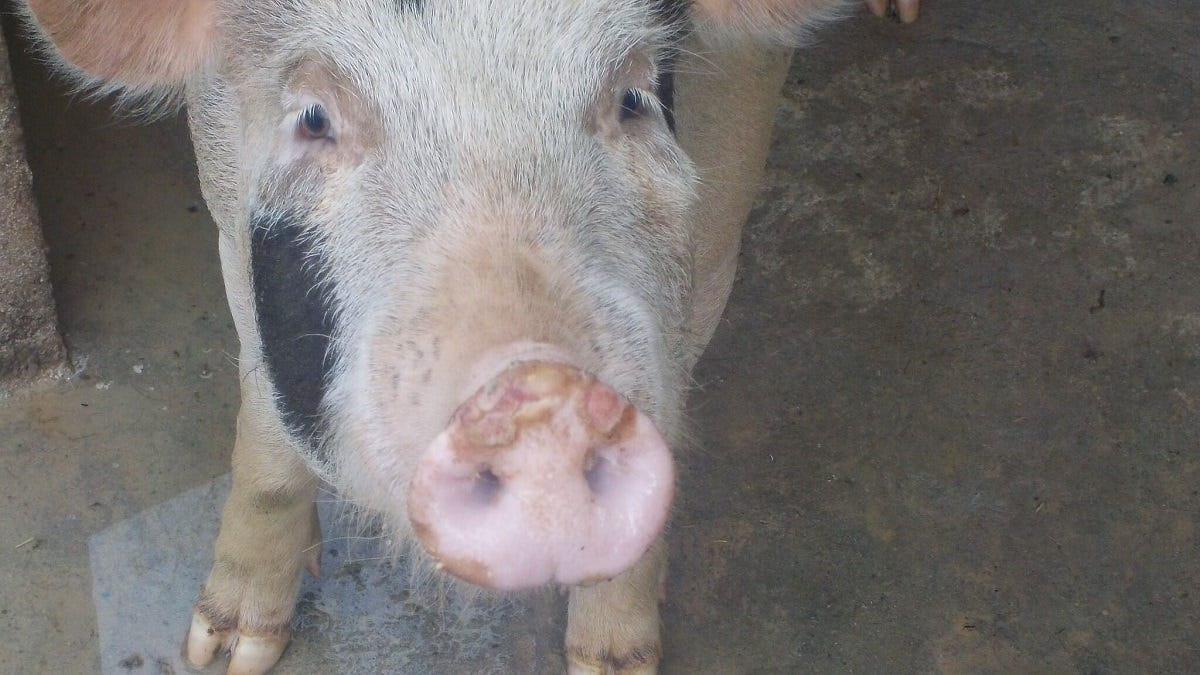Pigs are biggest foot and mouth disease risk, farmers hear at Tailem Bend
The Murraylands' primary producers are being urged to prepare for the possibility of an FMD outbreak in Australia, but not to be alarmed.

This post about public health and wellbeing is free to read. Please help Murray Bridge News tell more local stories by subscribing.

A veterinarian has warned farmers to “be alert, not alarmed” about the possibility of a foot and mouth disease outbreak in the Murraylands.
Australian authorities have been on high alert since the disease – which infects cattle, sheep, goats and related animals, but not humans – was detected in Indonesia earlier this year.
PIRSA district veterinary officer Jeremy Rogers addressed about 50 primary producers’ fears at a forum at Tailem Bend on Friday night.
The disease was unlikely to get in because a tourist failed to wash their boots or a resident imported a banned food product, he said.
After all, visitors and prohibited items had been coming from countries where FMD was present for years.
The biggest risk, he said, was people feeding table scraps to pigs.
If someone accidentally fed them a contaminated piece of meat, or something which had been in contact with one, and a pig became infected, “off it goes”.

“Giving any meat, or animal products, to pigs is illegal,” he said.
“None of you are going to be doing that, but you might know someone down the road who has a pet pig or a few pigs.”
That was how a foot and mouth outbreak had started in the United Kingdom in 2001, he said: a farmer fed scraps from a cruise ship to his pigs, then dropped them off at an abattoir on a Friday; 100 farms had been infected by the time the infection was detected on the Monday.
Another farmer who took 10 infected sheep to a market inadvertently infected 24,000 more, and the situation spiralled out of control.
How to tell if your animals have foot and mouth disease
Symptoms of foot and mouth disease are easier to spot in cattle and pigs than sheep and goats.
They may include blisters on the mouth, snout, tongue or lips, or between and above hooves; fever; drooling; and a reluctance to move.
Two questions could help farmers decide whether to worry, Mr Rogers said:
- Are symptoms visible in just in their feet, or in their mouths too?
- Is just one animal affected, or many?
If the answer to both questions was “yes”, it was time to call the experts, he said.
“If you see something you haven’t seen before and it’s in a lot of animals, let us know right away,” he said.
“In a couple of days it could have got away and skipped across the border.”
What would happen if an outbreak were detected in Australia?
If FMD were detected in Australia, export markets for any product derived from cattle, sheep or goats would close “overnight”, and competitors from overseas would rush to fill the gaps in the market.
Vaccines owned by the Australian government but stored in the UK would be imported as quickly as possible.
Back in Australia, all livestock movements would be frozen for at least three days.
Livestock in transit would be sent straight to the nearest sale yard, and owners would have to arrange to have them fed and looked after.

After that, a permit system would be introduced for all stock movements; farmers with appropriate biosecurity measures in place would go to the front of the queue.
Any livestock on a property where an infection was detected, and for several kilometres around, would be destroyed; those in surrounding areas would be vaccinated to stop the spread, and later destroyed anyway.
Their owners would be compensated at market value, bearing in mind that prices would likely crash due to the freeze on exports.
Affected properties would then need to be disinfected; where that was impossible, as in old wooden piggeries, buildings might have to be town down.
An FMD outbreak could cost the nation about $80 billion over 10 years, according to the federal Department of Agriculture, Fisheries and Forestry.
The industry would pay 20 per cent of that cost, through a special levy or other means.
How to reduce the risk to your herd
The best way to keep your herd safe was to have a biosecurity plan in place, Mr Rogers said.
That meant:
- keeping good records of animal movement
- requesting a health declaration before buying animals
- quarantining new animals before introducing them to herds or flocks
- monitoring animal health and reporting anything unusual
- regularly cleaning and disinfecting pens, vehicles, boots and equipment
“Get visitors to do foot baths … in a plastic tub with bleach or any disinfectant,” he said.
“It’s about messaging.
“You care, so they should care.”

The audience at the forum also heard about lumpy skin disease, which was carried by flies and mosquitoes.
Friday night’s event was hosted by Platinum Ag Services’ Murray Bridge branch.
- More information about FMD: pir.sa.gov.au.
- Report a suspected outbreak: Call the 24-hour Emergency Animal Disease Watch Hotline on 1800 675 888, or contact your vet.
- More information about what to feed pigs: pir.sa.gov.au.
You can help keep local stories like this one free for everyone to read. Subscribe to Murray Bridge News today and support your independent, locally owned news service, plus get access to exclusive stories you won’t find anywhere else, from just $5 a month.





